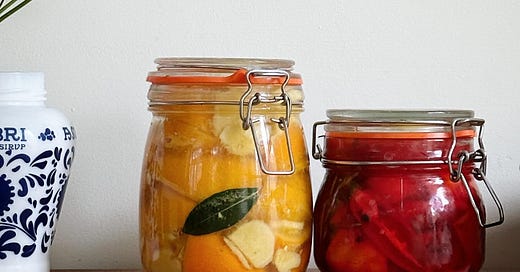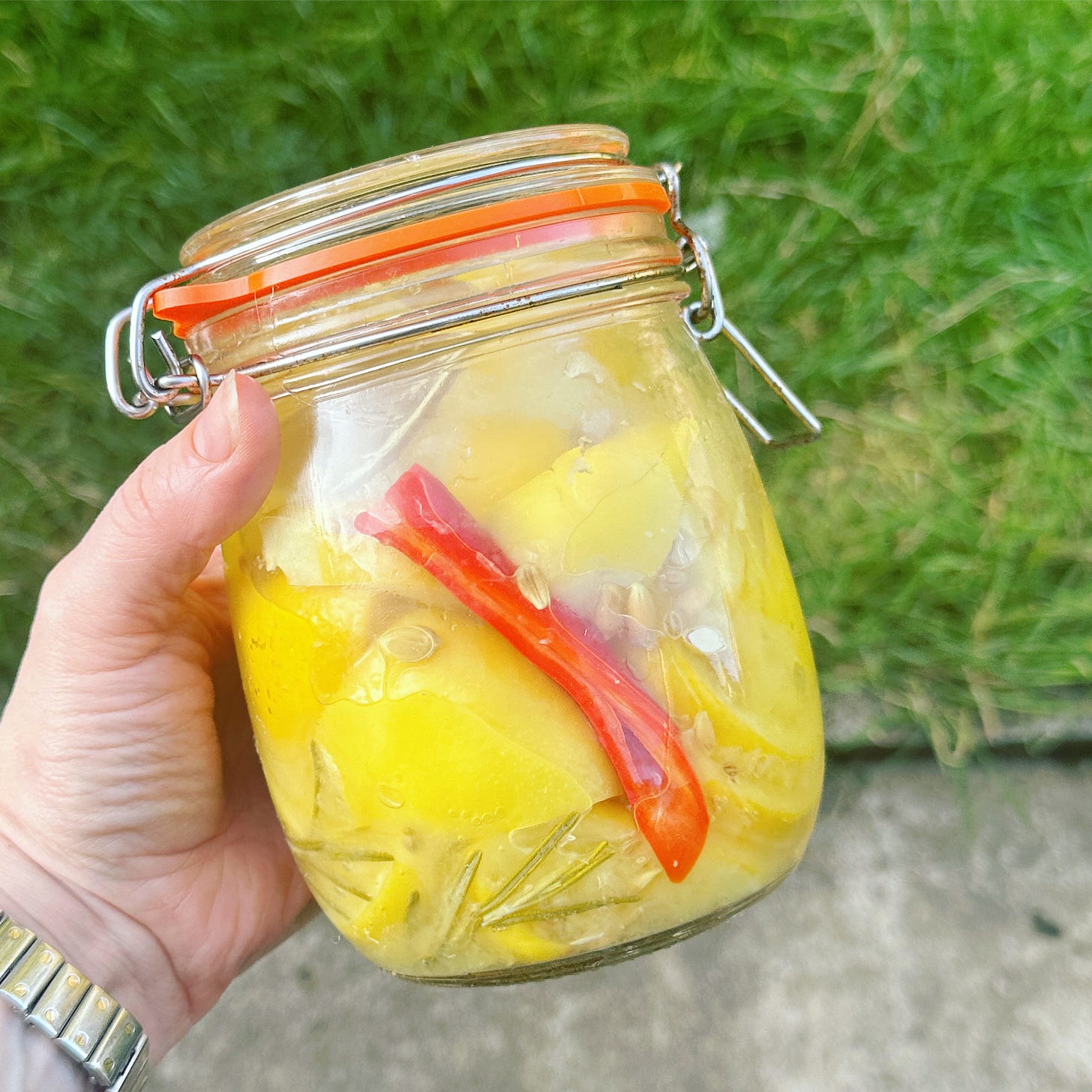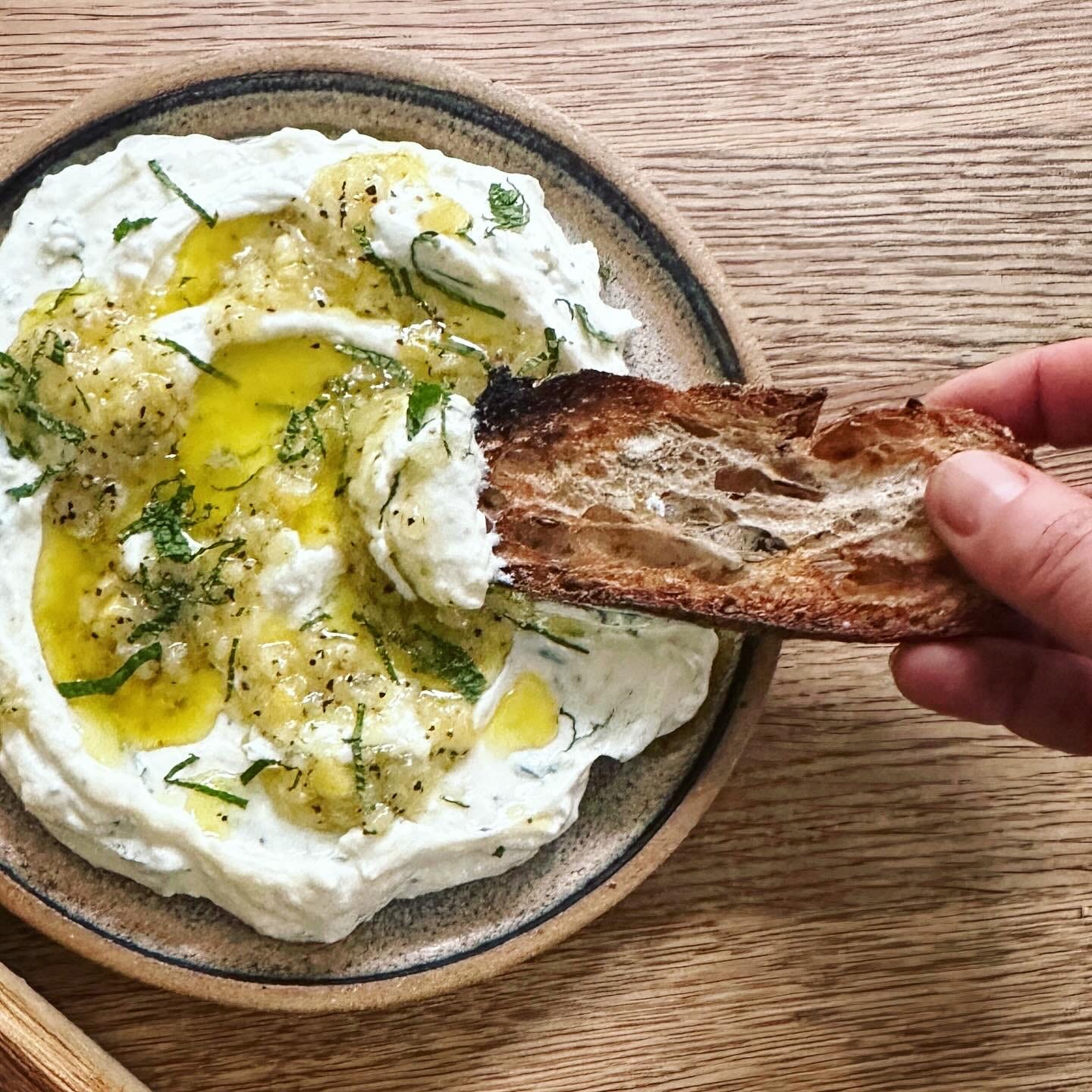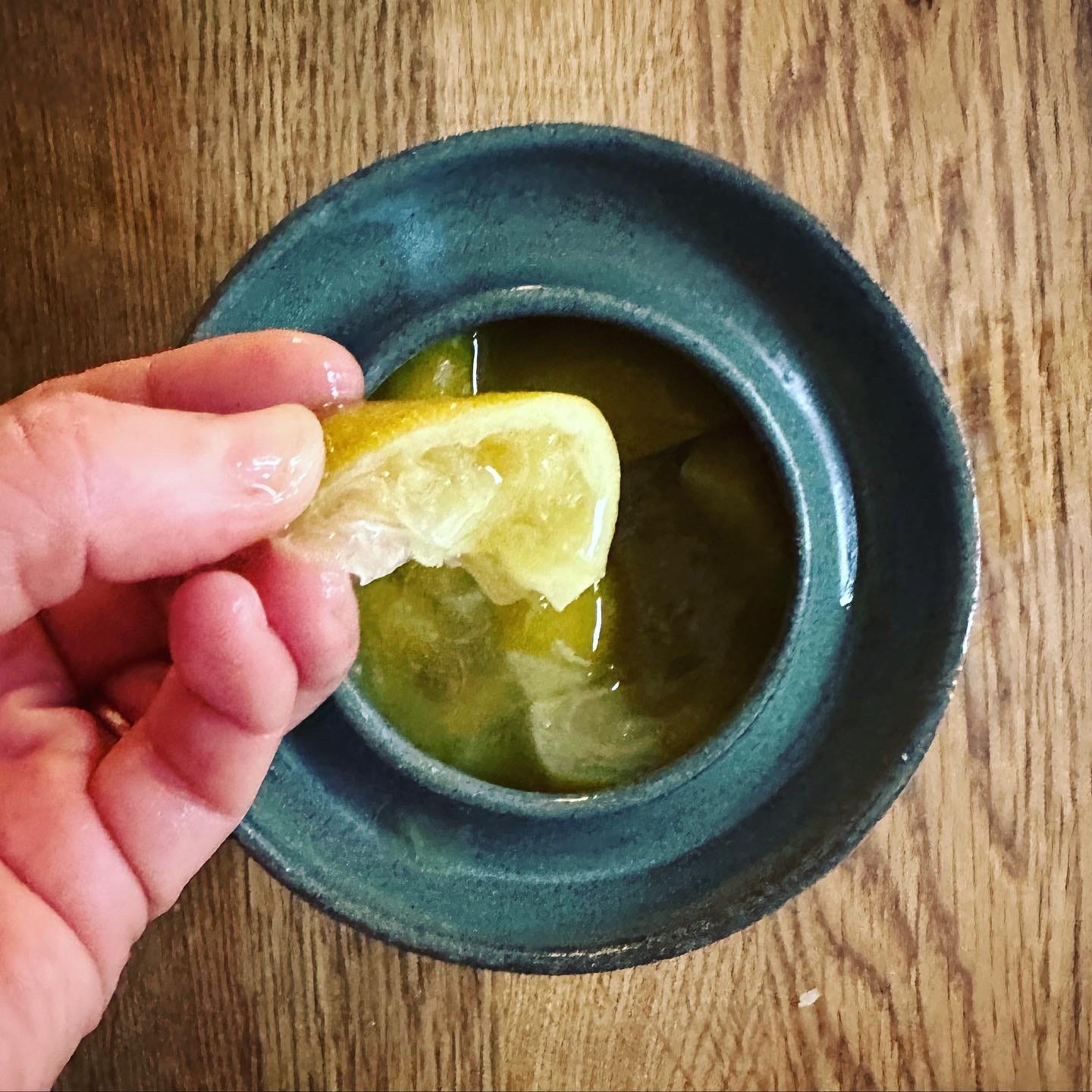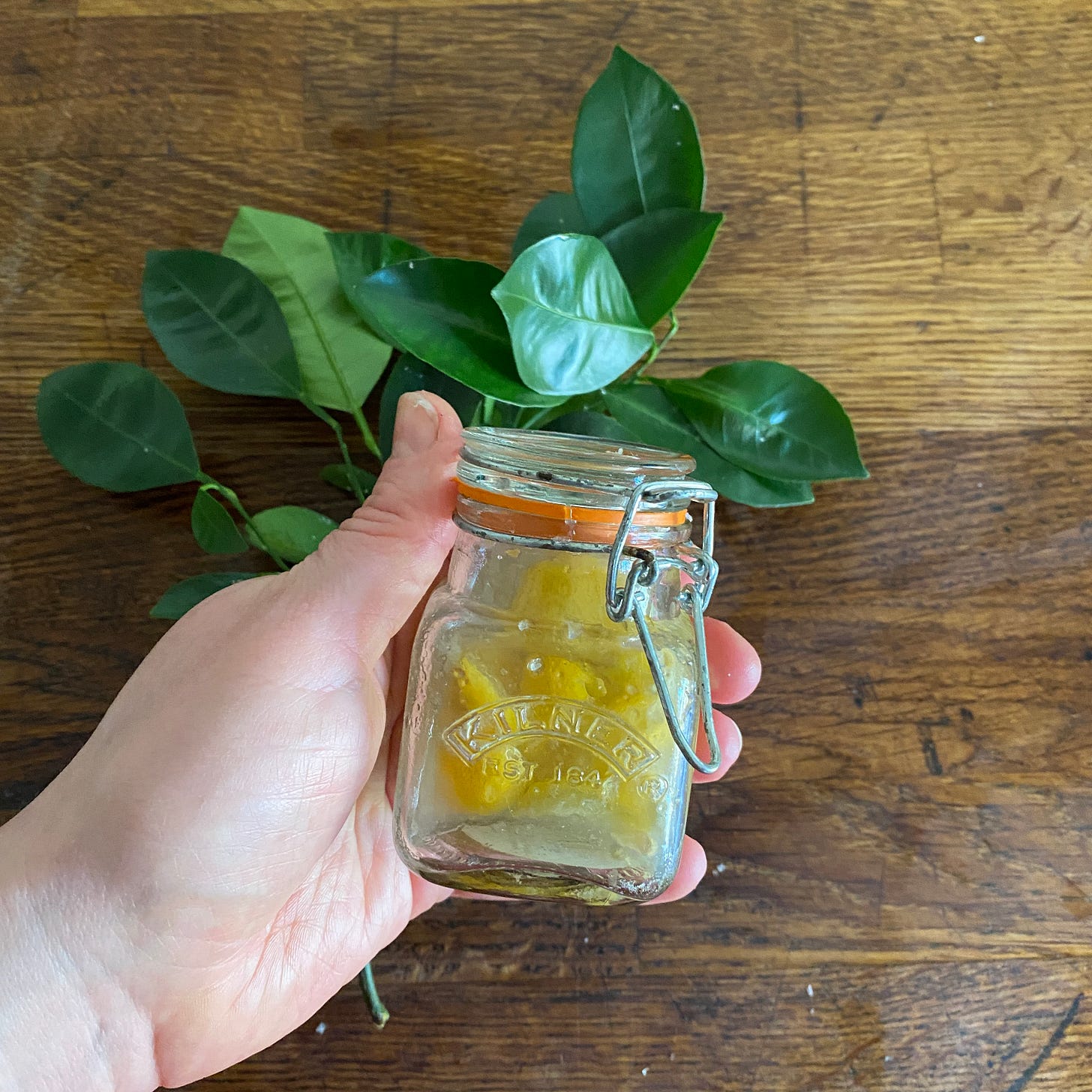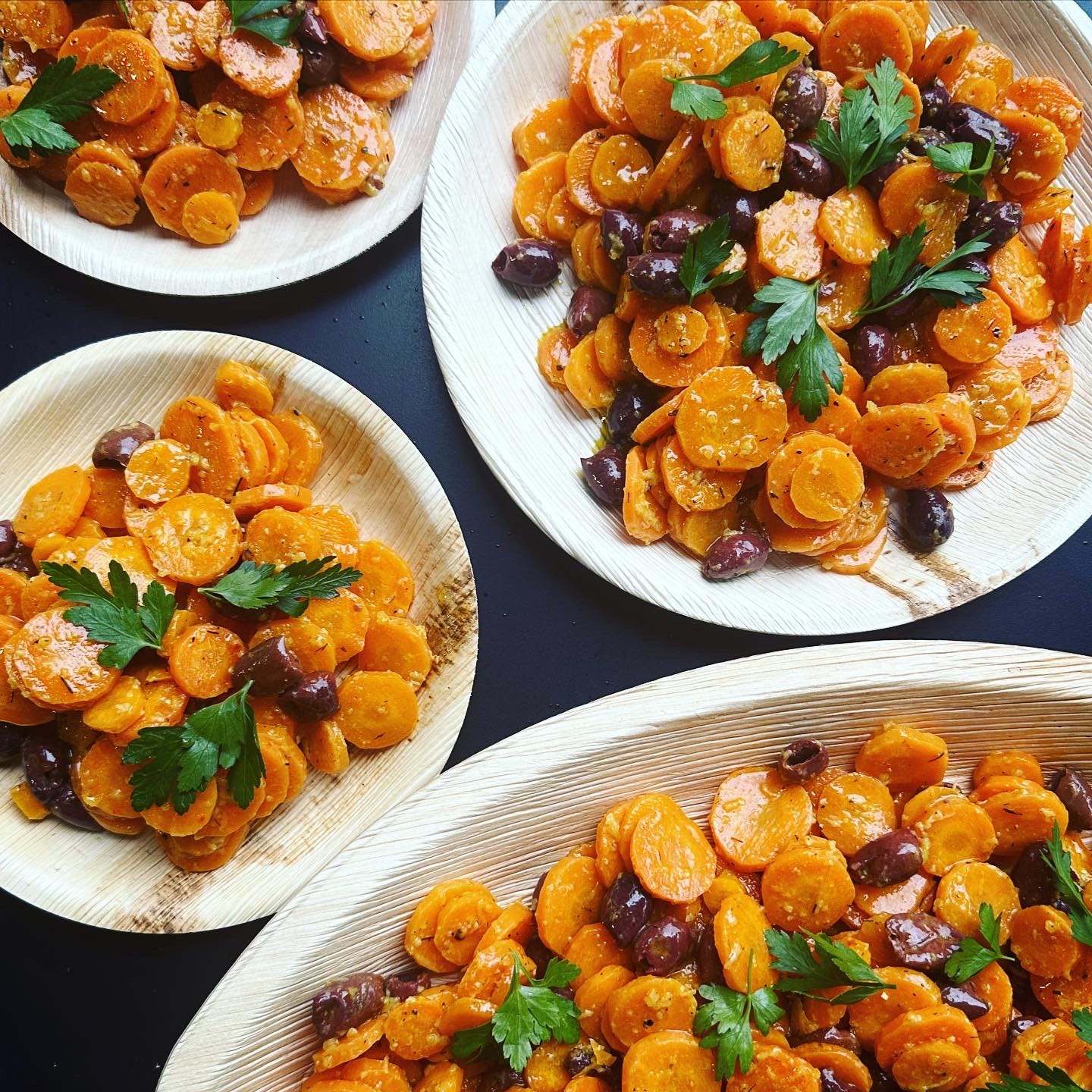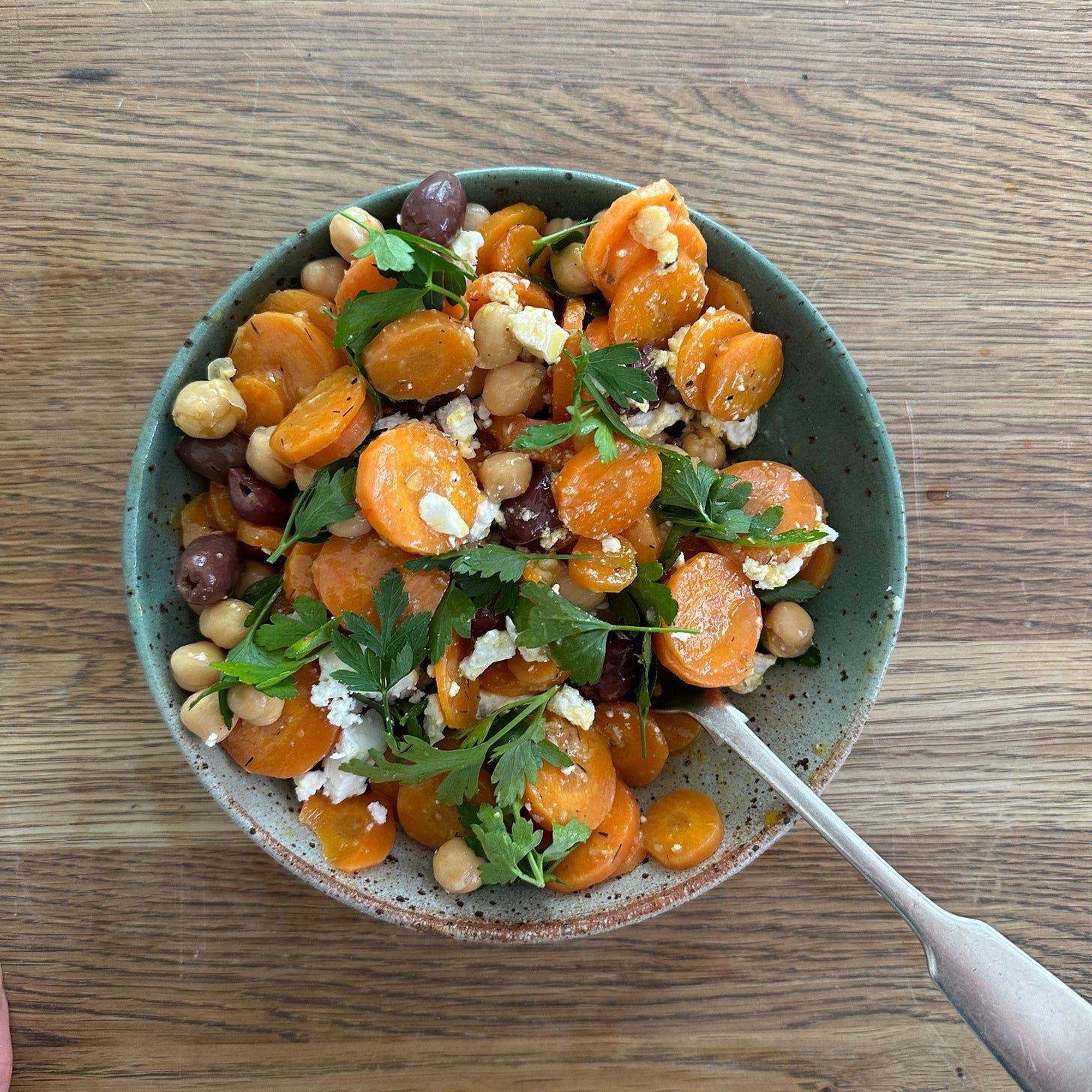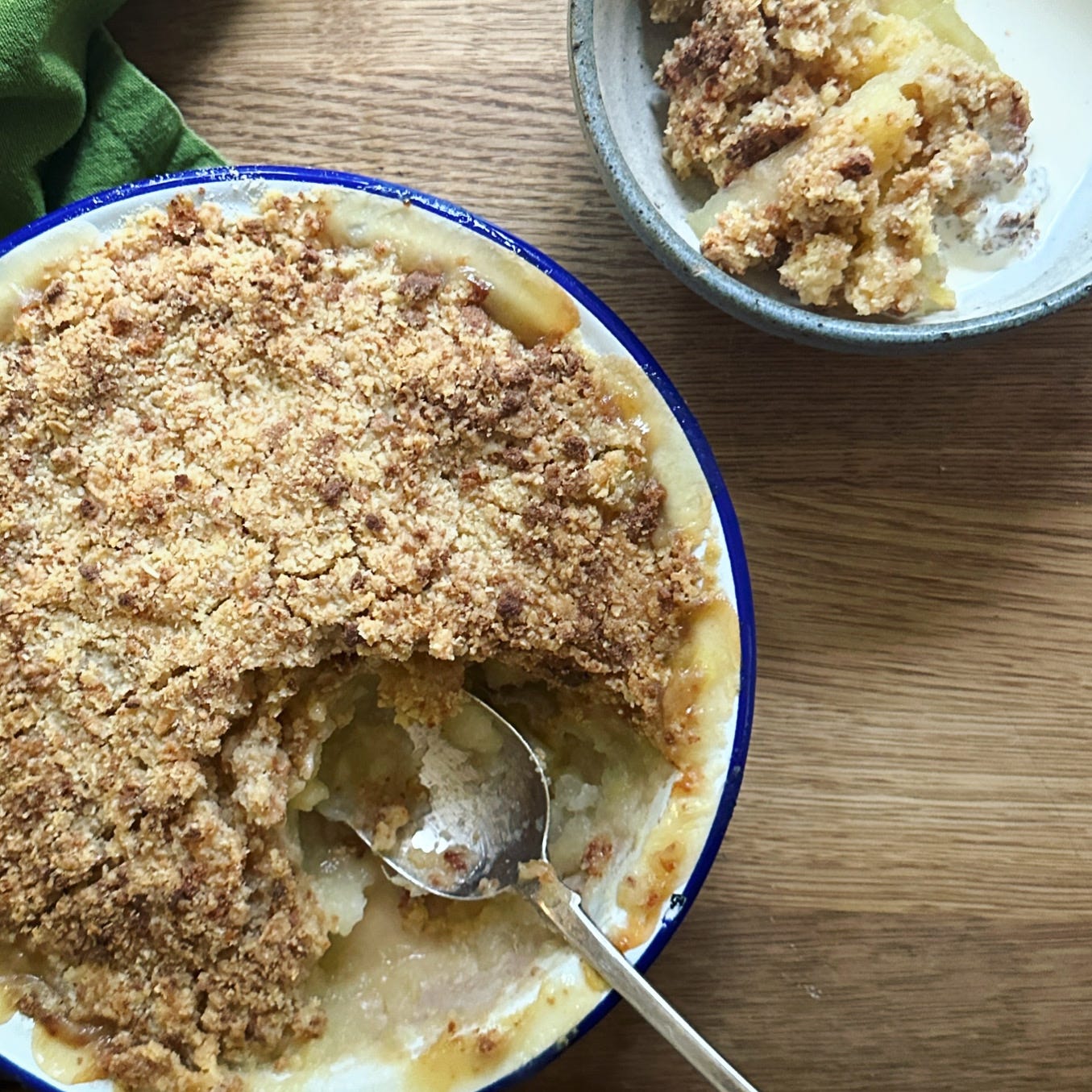In Good Taste #34: Preserved Seville and Blood Oranges
It's not all about marmalade - alternative uses for winter citrus; plus my favourite carrot salad and an apple crumble; American Fiction and other Cultural Fun
Well, hello there! How are you?
Good I hope. Thank you so much for being here.
(Not up for the chitchat? Completely get it. Click the email title to go to a web-based version then jump straight to the preserved citrus recipe, the carrot salad, the apple crumble or Cultural Fun.)
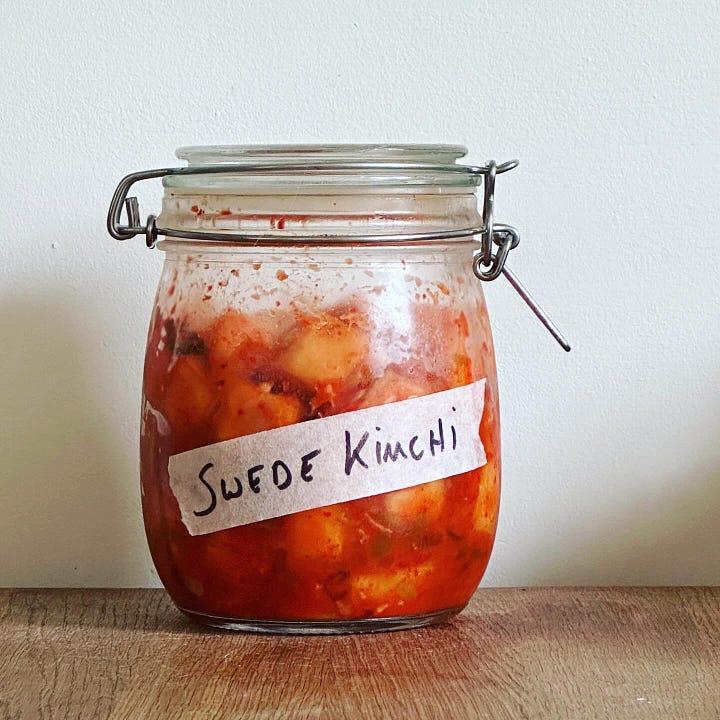
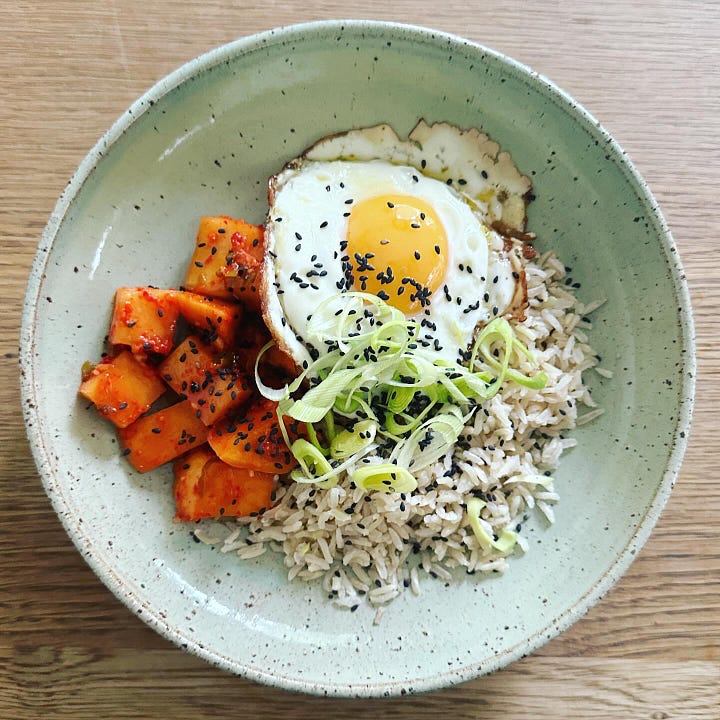
I created some recipes for (north and east London veg box scheme) Growing Communities that I wanted to share with you. A swede kimchi and some pickled beets, plus a couple of ideas of what to do with them. If you’re in the catchment area I can really recommend GC. I always like the bag of veg I get from them and they do a lot to promote sustainable, localised food systems. Look out for more recipes from me on their website.
In other news, April dates for my sessions at The Dusty Knuckle in Dalston are on sale now. One pasta class on the 16th and a fermentation workshop on the 30th. The tickets are selling fast though so be speedy if you want to come along!
Scheduling issues mean that I’ve taught my last class at Borough Kitchen for a couple of months, but I’ll be back there towards the end of April I hope and with some dates throughout the summer. Plus I’m working on something Oxfordshire-based which I’m super excited about and will be able to announce soon. Subscribe to be the first to know and for a discount on the first course…
I’m also available for private lessons (a voucher makes a great present) and corporate or community workshops. Get in touch if you’re interested!
Lemons are not the only fruit
Back in the autumn of last year we talked about preserved lemons. The theory at work is very similar to other brine pickles we’ve made: pickled cucumbers, lacto tomatoes and, more recently, Jerusalem artichokes. We create a salty environment in which bad bacteria can’t survive but lactic acid bacteria can. The LAB then turn the carbohydrates in the produce into lactic acid which pickles and preserves it.
There’s a difference though. With our lemons the brine isn’t just made of salt and water but of salt and lemon juice. So there’s a sort of double pickle going on: first the citric acid of the lemon juice and then the lactic acid. We also used a higher percentage of salt in the brine. Unlike, say, the cucumbers we’re unlikely to munch on a preserved lemon on its own. I mean, I wouldn’t judge you if you did. But you probably won’t. It’s an ingredient. We use only a little of it at a time. So, instead of 2-5% salt we use more like 20%.
I hope you made some lemons and experimented with some of the recipes once they were ready. If you haven’t dipped a toe yet then start with the yoghurt dip which is ludicrously easy and a real crowd pleaser - it always goes down well when I serve it at workshops.
I’ve got another preserved lemon recipe for you today with a few more to come over the next couple of weeks. They’re possibly the thing I get asked about most - in terms of how to cook with them anyway - so I want to make sure your jars aren’t going unused.
But before we get there, I want to talk about how we can use the same method to preserve other citrus fruit. There’s so much beautiful citrus around right now. I know some people are devoted to their winter marmalade making ritual, but the boiling, slicing, simmering and messing about with frozen saucers isn’t for everyone.
I do happen to like making marmalade - it’s a perfect Sunday afternoon activity - but I still have loads of last year’s batch left and I didn’t want to miss my chance to play with some of 2024’s Seville oranges so I thought I would preserve a few.
I also made a batch of blood oranges. I’ve previously done limes which were great too. Although the method is exactly the same, each fruit brings its own character to the preserve so you get very different results. Lime has that unmistakable zinginess, blood orange are sweeter and, of course, have that beautiful colour (maintained here but so often lost or diluted if you try and cook with them). And Sevilles bring that distinctive floral bitterness and a real complexity.
There are fancier citruses around too. Try kalamansi limes or kumquats. Or bergamots (if you’re absolutely made of money). All would work here.
Recipe: Preserved Citrus
Make as much or as little as you like here, just try and find a jar that matches the quantity so there’s as little air at the top as possible. I have a little calamansi lime tree (aka calamondin orange - the same one I got the leaves from for the pre-Christmas mulled wine) that produces only a couple of fruit at a time. One “crop” went into this jar.
Ingredients
citrus fruit of your choice
flaky sea salt
optional flavourings (herbs, spices, chillies etc. - see notes)
Method
Make sure your jar is scrupulously clean.
Wash the fruit and remove any stalky bits. Cut each lengthways into quarters. (If you don’t have a pickle weight, reserve one half fruit to serve that purpose.)
Squeeze four quarters into your jar. Really give them a good squish, getting as much juice out as possible. Drop the skin into the jar too. Don’t worry about pips at this stage. They’re much easier to deal with once the fruit has fermented and softened.
Add 1 tbsp flaky sea salt (if using smaller grained salt, a tsp will suffice).
Add a little of any extra spices if using (see notes).
Repeat these steps (squeeze four quarters, follow with salt and spices) until all the fruits are gone.
Use a pickle weight or your final citrus half to keep all the squished quarters under the brine then seal the jar. Ideally, the top of the jar will push on the pickle weight/citrus half which, in turn, will push the other pieces of fruit down and keep them submerged. If some of them are exposed to the air (some fruits are juicier than others) add a little water.
Leave at room temperature, out of direct sunlight. Your citrus won’t create much gas so doesn’t need regular burping but check occasionally that they are still covered by the brine – if they have begun to dry out top up with more juice or water or they will go brown and oxidised. If the pickle weight fruit half goes mouldy, replace it.
The preserve is ready when the peels are entirely soft. This will take anywhere between one and three months. Once ready, move the jar to the fridge where they its contents will keep indefinitely.
Notes (If Ifs And Ands Were Pots And Pans…)
Adding no extra flavourings to your chosen citrus makes it more versatile but it’s also fun to play around. Bay leaves, chillies, cinnamon sticks, star anise, black peppercorns, cardamom and coriander seeds go with pretty much any citrus but have a think about the qualities of the particular fruit and what would best compliment it.
For my most recent jars I put chilli, rosemary and black peppercorns with the blood oranges and bay leaves and ginger with the Sevilles (in imitation of my lampshade-painting friend Alvaro who also makes exceptional marmalade with those additions). Both jars are coming along well, but aren’t quite ready yet. I’ll revisit with some recipes when they are.
When done, I like to turn most of my preserved citrus into paste. Tip the whole contents of the jar into a bowl and, one by one, run a thumb over the pulp side of each quarter, removing any pips or whole spices. It takes just a second and is so much easier than trying to get rid of the pips when the fruit is still fresh. Each de-pipped piece goes in a food processor, along with any citrusy-salty pulp or brine and everything is blitzed to a paste before returning to the jar. I’ve always got a jar or two of this in the fridge as it’s useful stuff to have on hand for salad dressings, can be used in place of lemon zest in almost any recipe and also lends great depth of flavour to soups and stews.
If you use Sevilles, do bear in mind that they are very bitter. Obviously there’s a lot of sugar that goes into marmalade and you haven’t got that here. I’m going to be using these oranges a tiny bit at a time to add complexity to sweet dishes or alongside salty ingredients such as anchovies since salt suppresses the perception of bitterness.
Recipe: Greek Orange Juice Carrots with Preserved Citrus
Serves 6-8 as part of a spread
This is my version of a recipe from Aglaia Kremezi’s book Mediteranean Vegetarian Feasts. It’s so good - one of my all-time favourite dishes - and went down well at my supper clubs last summer. I usually use preserved lemons but you could sub in any other preserved citrus you might be making.
Ingredients
1kg carrots, peeled and cut into pound coin thick rounds
olive oil (use some good stuff, Greek if possible!)
salt
500ml orange juice
2 garlic cloves, crushed or minced
1-2 tbsp preserved lemon paste (or other preserved citrus)
1 tbsp fresh thyme leaves, finely chopped
pinch chilli flakes (optional)
black pepper
100g kalamata or nicosia olives
small bunch flat leaf parsley, roughly chopped or a couple of handfuls of rocket (optional)
Method
Put a large frying pan over medium-high heat and add a generous slug of olive oil. Add a few handfuls of carrot slices, enough to cover the bottom of the pan in a single layer. Season with a pinch of salt and toss to make sure everything is coated in oil. Spread the carrot slices out and cook, stirring occasionally until shiny and beginning to soften.
Add some orange juice - the amount will depend on what proportion of the carrots fitted in your pan for this one batch. Give each batch an equal share. It should be enough to surround but not cover the slices. Cook on a high heat, stirring occasionally, until the orange juice has nearly all evaporated leaving just a sweet, sticky residue. The carrots should be soft but still have bite. This will probably take five minutes.
Set aside the first batch in a large bowl or container and repeat until you’ve used all the carrots. Don’t scrimp on the olive oil.
When the final batch of is done, lower the heat and add another splash of oil to the pan. Cook the garlic for 1-2 minutes, just until fragrant - don’t let it brown or burn.
Ad the garlic to the carrot slices along with the preserved lemon, thyme leaves and chilli flakes. Add the olives too and season generously with black pepper. Toss to combine evenly then taste and season with salt if necessary. The lemon and olives bring quite a bit so you’re unlikely to need much more.
Eat immediately or let cool to room temperature. Garnish with the parsley or rocket just before serving.
Notes (If Ifs And Ands Were Pots And Pans…)
This keeps really well in the fridge and can be made several days before you want to serve it. It’s also robust enough to make an exceptionally good lunchbox salad, especially bulked out a bit with cooked chickpeas and a crumble of feta cheese.
Kremezi instructs to use unpitted black olives for better flavour but I like to eat without fear of breaking my teeth so prefer to cheat and use pre-pitted ones.
Recipe: Apple Crumble
Serves 4
Not all recipes need to be fermented. This is just a really good crumble recipe, perfect for bringing a bit of cosiness to the still-chilly evenings.
Ingredients
500g (approx - two or three) Bramley apples, peeled, cored and sliced
500g (approx - three of four) Cox or Braeburn apples, peeled, cored and sliced
Squeeze of lemon juice
Caster sugar for the apples if needed
100g plain flour
125g chilled butter, cubed
50g ground almonds
50g crunchy amaretti biscuits, crushed
50g caster sugar
tsp ground cinnamon
pinch of salt
Method
Set the oven to 180°C.
Put the apples in a pan with a squeeze of lemon juice, about 100ml water and a tbsp of caster sugar. Let them cook over a medium heat for 10-15 mins or so, stirring occasionally, until the cooking apples have broken down into fluff and the Coxes/Braeburns are soft but retaining their shape.
Taste the apples and add more sugar if you think it needs it. I like the apples to be a tart contrast to the sweet topping so don’t usually add much more. Transfer the apple mixture to an oven-proof dish and allow to cool slightly.
Put the butter and flour in a food processor and pulse until they have reached a course breadcrumb texture with a few little pea-sized lumps of butter. Add the almonds, crushed biscuits, sugar, cinnamon and salt. Combine well and spread over the apples.
Bake for about 30-40 mins, until golden brown on top and bubbling round the edges. Eat with cream, ice cream or custard.
Notes (If Ifs And Ands Were Pots And Pans…)
I really like to use both “cookers” and “eaters” in an apple crumble. The Bramleys break down into comforting mush and the Coxes or Braeburns provide a bit of texture. They’re also sweeter so require hardly any added sugar. But use just one type if you prefer or sub in some rhubarb, pear, quince or anything else you fancy. I often also add a handful of raisins or sultanas.
Ground ginger or cardamom is nice instead of (or as well as) the cinnamon.
I recommend multiplying up the recipe and freezing the extra apple mixture and crumble topping separately. I prefer doing this to freezing a fully-constructed crumble which takes a serving dish out of circulation. You can defrost the cooked fruit in a pan with the help of a bit of water and top with the crumble straight from the freezer. It’s very comforting to know you have a pudding on standby in case of emergencies.
Cultural Fun
The Freakonomics Radio podcast has been doing a mini-series on physicist Richard Feynman. It’s been inspiring to hear about his infinite curiosity and drive to understand the world. A story not mentioned in any of the programmes but that demonstrates this perfectly is the fact he once spent a whole evening breaking spaghetti in a bid to find out why a strand always snaps into three pieces rather than two.
James and I found ourselves in Woking last week and visited the Lightbox gallery and museum (incredibly friendly staff). They had an exhibition of tapestries by Grayson Perry, The Vanity of Small Differences, exploring themes of social mobility, taste and class. It was a sort of modern, reverse Rakes Progess in which protagonist Tim Rakewell leaves behind humble beginnings to become a billionaire software developer before meeting an unfortunate end. The works aren’t new - they were inspired by encounters Perry had whilst filming his 2012 Channel 4 programme All In The Best Possible Taste - but it was the first time I’d seen them and they chimed with a lot of stuff I’ve been thinking about lately. Specifically about taste, what is is and whether it signifies much other than finely tuned sensitivity to class.
Not long after, I listened to the latest episode of the Full English podcast all about the conspicuous consumption of fine dining which rang a lot of the same bells.
We also saw (Oscar Best Picture nominee) American Fiction and loved it. Jeffrey Wright is so great as a grumpy academic novelist who writes a spoof gangs’n’guns book after being told that his work isn’t “black” enough.
It was really interesting on the perils and pitfalls of identity politics but - crucially - very funny with it. There’s a particularly lovely scene early on between Wright and Tracee Ellis Ross who plays his sister, just talking and joking as they drive along, the kind of dialogue that sounds so easy and natural but so hard to pull off. The ending is very clever too.
Bye! See you next week!
In the meantime, if you felt like sharing In Good Taste with friends or family who might enjoy it, you can do so with the button below. It would mean the world to me. Thanks so much.
In Good Taste is a Sycamore Smyth newsletter by me, Clare Heal.
You can also find me on Instagram or visit my website to find information about my catering work, cookery lessons and upcoming events.


